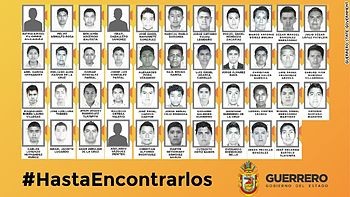On the evening of September 26, 2014, in the small town of Iguala, Guerrero, Mexico, a few hour’s drive north from the coastline of the Pacific Ocean, students from a local teachers’ college gathered to board their chartered buses for a trip to Mexico City where they planned to protest the pervasive corruption and impunity of their government. The students never arrived in Mexico City. Their friends and families never heard from them again. As one parent said, “It was as if my 20-year-old son never existed. He’d been an illusion for two decades.”
A parent’s loss of a child is a brutal, painful, tragic event that tears at their religious beliefs and soul. But what about the loss of 43 young college students who simply vanished from the face of the earth one evening? They were like many college-age students in the world, on the cusp of a new life; unapologetic idealists ready to change the world for the better. Those who disappeared have never been accounted for.
It is difficult to imagine that a government in the 21st century would not aggressively pursue justice for the victims and families of 43 of its missing university students. Would it have made a difference if one of the missing students had been the son of a politician or the son or grandson of a wealthy political donor? Does one’s economic status and lineage in this society dictate the level of justice they are entitled to?
The word “disappeared” is deceptive. It appears to be neutral, more acceptable than murdered, tortured, or slaughtered because it implies none of the violence and viciousness of the acts that caused the disappearance. However, for the relatives and friends of those who have vanished, the constant emotional turmoil grinds their lives away in small pieces. There are no remains, no burial, no closure, and no chance to properly grieve. The patience of the parents of the missing students and their communities frayed and finally snapped with full-scale demonstrations in Mexico City.
The government reacted quickly, expediting the search for answers, but it was driven by political and not humanitarian or scientific forces. On cue, the government produced a self-serving and amateurish investigative report that blamed low-ranking police in Iguala of “herding the students into pickup trucks and transporting them to a trash dump just outside of town where members of an unnamed narco-terrorists’ criminal gang murdered the students, burned their bodies using only ‘five gallons of fuel,’ gathered the ashes and threw them into a nearby river—end of story. Next question?”
None of the government’s evidence survived the scrutiny of independent experts from the Inter-American Commission on Human Rights (IACHR). Shortly after the government submitted the results of its investigation, the “cover-up” started to unravel; the government’s use of delaying tactics, inaction, and indifference had failed to divert the truth. The government’s evidence was characterized by an international group of forensic experts as “improbable and scientifically impossible to have occurred.”
NOTE: The IACHR experts calculated the cremation of the 43 bodies, as the government claimed, required 44 tons of wood, 13 tons of diesel, 18,000 tires and 60 hours to cremate the bodies. Satellite imagery showed no evidence of fires or smoke at the dump site during the last two weeks of September 2014. The government’s explanation of the disappearance of the 43 university students was shown to be a shameless attempt to hide the criminal activities of the Institutional Revolutionary Party (PRI). The PRI’s fingerprints were visible through their deceit.
An onsite inspection of the area described by the government’s witnesses as the “killing field” revealed no forensic evidence. Two critical questions remained unanswered: who ordered the killings and why? Those responsible for the disappearance of the 43 students fled like cockroaches into the darkness to avoid being illuminated by the truth. They purchased mansions in Miami and Spain’s Gold Coast. As Honoré de Balzac, a 19th century French novelist observed, “Laws are spider webs through which the big flies pass, and the little ones get caught.” As of September 2024, there is still no closure. The only thing that is certain is the continuation of uncertainty for the students’ families as they watch the clock record another minute…in another hour…in another day… in another week… in another month… in another year.








Chuck Bins • Sep 12, 2024 at 12:45 pm
This is indeed a bizarre story. Why would anyone do this? Is it possible that they were divided up and forced into service or slavery by drug lords in Mexico or Columbia?